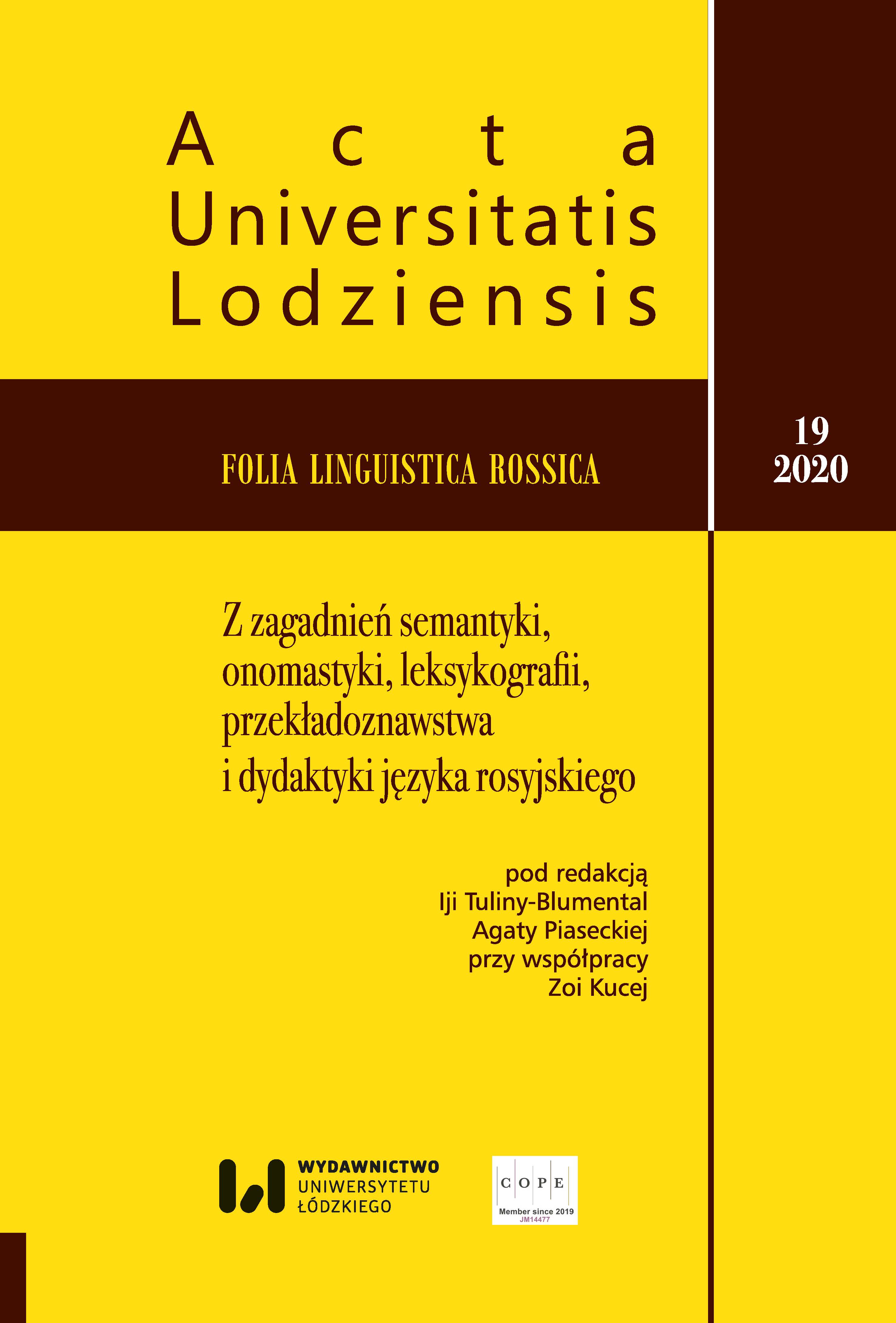Field arrangement of verbs (on the basis of verbs with the meaning ‘to defend’ in the Russian language)
DOI:
https://doi.org/10.18778/1731-8025.19.08Keywords:
lexical semantic group, field structure, nucleus, periphery, causative verb, semantic structureAbstract
The author looks into the lexical semantic group of Russian defence verbs. The point of the research is to trace peculiarities of the semantic structure of verbs containing the elements of ‘defend’ and ‘cause.’ Another question is the principles governing the causative defence verbs in terms of field organization.
The analysis seeks answers to some disputable questions: distinctions between causative and non-causative verbs, boundaries of the causative verbs class, the nucleus and peripheral elements of the causative category within the lexical semantic group of defence verbs. The relevance of the research is increased by the insufficient amount of causativity analyses of specific lexical semantic groups in the Russian language.
The research methods are the contextual method, transformation method, component analysis, distributive analysis, and dictionary definitions analysis.
It was found out that the core and periphery of the lexical semantic group of defence verbs and causative verbs do not coincide. Among defence verbs, there is one item which does not contain the element ‘cause’ in its semantic structure. The criteria of the peripheral position of Russian defence verbs among causative verbs have been systematized.
References
Апресян, Ю.Д. (1995). Избранные труды: в 2 т. Т. 1: Лексическая семантика: Синонимические средства языка. Москва: Шк. «Яз. рус. культуры».
Google Scholar
Апресян, Ю.Д. (2004). Принципы организации центра и периферии в лексике и грамматике. В: Типологические обоснования в грамматике, 20−35. Москва: Знак.
Google Scholar
Бондарко, А.В. (1971). Грамматическая категория и контекст. Ленинград: Наука.
Google Scholar
Бондарко, А.В. (2005). Теория морфологических категорий и аспектологические исследования. Москва: Языки славянских культур.
Google Scholar
Виноградов, В.В. (1986). Русский язык: граммат. учение о слове. Москва: Высшая школа.
Google Scholar
Долгих, Н.Г. (1973). Теория семантического поля на современном этапе развития семасиологии. Филологические науки, 1, 89−98.
Google Scholar
Золотова, Г.А. (1973). Очерк функционального синтаксиса русского языка. Москва: Наука.
Google Scholar
Левицкий, В.В., Стернин, И.А. (1989). Экспериментальные методы в семасиологии. Воронеж: Изд-во Воронежского государственного университета.
Google Scholar
Национальный корпус русского языка (2003−2020), http://www.ruscorpora.ru (доступ: 5.08.2020).
Google Scholar
Норман, Б.Ю. (1972). Переходность, залог, возвратность: на материале болг. и др. слав. яз. Минск: Изд-во БГУ.
Google Scholar
Ожегов, С.И. (1987). Словарь русского языка. Москва: Русский язык.
Google Scholar
Попова, З.Д. (ред.). (1989). Полевые структуры в системе языка. Воронеж: Изд-во Воронежского государственного университета.
Google Scholar
Супрун, А.Е. (1975). Лексическая система и методы ее изучения. Проблема системности лексики. В: Методы изучения лексики, 5−22. Минск: Белорусский государственный университет.
Google Scholar
Филиппов, А.В. (1978). К вопросу о каузативных и некаузативных глаголах. Русский язык в школе, 1, 90−94.
Google Scholar
Apresyan, Yu.D. (1995). Izbrannye trudy: v 2 t. T. 1: Leksicheskaya semantika: Sinonimicheskie sredstva yazyka. Moscow: Shk. «Yaz. rus. Kul’tury».
Google Scholar
Apresyan, Yu.D. (2004). Printsipy organizatsii tsentra i periferii v leksike i grammatike. V: Tipologicheskie obosnovaniya v grammatike, 20−35. Moscow: Znak.
Google Scholar
Bondarko, A.V. (1971). Grammaticheskaya kategoriya i kontekst. Leningrad: Nauka.
Google Scholar
Bondarko, A.V. (2005). Teoriya morfologicheskikh kategorii i aspektologicheskie issledovaniya. Moscow: Yazyki slavyanskikh kul’tur.
Google Scholar
Dolgikh, N.G. (1973). Teoriya semanticheskogo polya na sovremennom etape razvitiya semasiologii. Filologicheskie nauki, 1, 89−98.
Google Scholar
Filippov, A.V. (1978). K voprosu o kauzativnykh i nekauzativnykh glagolakh. Russkii yazyk v shkole, 1, 90−94.
Google Scholar
Levitskii, V.V., Sternin, I.A. (1989). Eksperimental’nye metody v semasiologii. Voronezh: Izd-vo Voronezhskogo gosudarstvennogo universiteta.
Google Scholar
Natsional’nyi korpus russkogo yazyka (2003−2020), http://www.ruscorpora.ru (dostup: 5.08.2020).
Google Scholar
Norman, B.Yu. (1972). Perekhodnost’, zalog, vozvratnost’: na materiale bolg. i dr. slav. yaz. Minsk: Izd-vo BGU.
Google Scholar
Ozhegov, S.I. (1987). Slovar’ russkogo yazyka. Moscow: Russkii yazyk.
Google Scholar
Popova, Z.D. (red.). (1989). Polevye struktury v sisteme yazyka. Voronezh: Izd-vo Voronezhskogo gosudarstvennogo universiteta.
Google Scholar
Suprun, A.E. (1975). Leksicheskaya sistema i metody ee izucheniya. Problema sistemnosti leksiki. V: Metody izucheniya leksiki, 5−22. Minsk: Belorusskii gosudarstvennyi universitet.
Google Scholar
Vinogradov, V.V. (1986). Russkii yazyk: grammat. uchenie o slove. Moscow: Vysshaya shkola.
Google Scholar
Zolotova, G.A. (1973). Ocherk funktsional’nogo sintaksisa russkogo yazyka. Moscow: Nauka.
Google Scholar
Downloads
Published
How to Cite
Issue
Section
License

This work is licensed under a Creative Commons Attribution-NonCommercial-NoDerivatives 4.0 International License.









